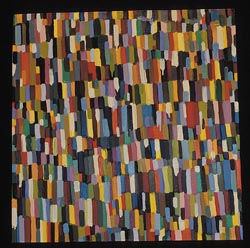‘Confusion: Disorientation and Synthesis’
by Arthur FournierNews Office
 Time Sensitive, oil on linen, 2000, by Martina Nehrling, will be exhibited in the Cochrane-Woods Art Center during the art history conference titled “Confusion: Disorientation and Synthesis.” |
Moments of disorder will be examined
“Confusion: Disorientation and Synthesis,” a two-day conference co-sponsored by the Department of Art History and the journal Critical Inquiry, will bring together scholars from a variety of fields to examine how moments of confusion or apparent disorder in works of art can serve as points of entry into the larger systems of meaning in which the works are embedded.
The event, which will include presentations by Chicago faculty and graduate students as well as their colleagues from around the country, begins this afternoon in the Cochrane-Woods Art Center at 5540 S. Greenwood Ave., and will continue throughout the day Friday, March 30. “Confusion: Disorientation and Synthesis” will feature works in painting and installation art as well as academic papers on architecture, visual art, film, literature and new media.
Whitney Rugg and Geoff Manaugh, graduate students in Art History and co-organizers of the conference, said they want the interdisciplinary character of the event to serve as a counterpoint to more traditional scholarly modes of engaging with works of art. “Art historians often seek immediate correspondence between a work of art and a system of reality, explaining a work of art through a one-to-one orientation with a textual or theoretical source,” explained Rugg. “But this rational approach doesn’t necessarily take into account the inherent lapses, or moments of disorientation, within a given work,” she continued. “As the papers at our conference show, it is often in these moments of confusion within a work that the fusion of a new system of reality is synthesized.”
The conference will begin at 4:30 p.m. today with Saskia Sassen, Professor in Sociology, giving the keynote address titled “The Global City: De-Nationalizing Time and Space.” She will give her presentation in Room 157 in the Cochrane-Woods Art Center. Homi Bhabha, the Chester D. Tripp Distinguished Service Professor in the Humanities, will respond to Sassen’s presentation, which will be followed by a reception.
The conference will re-convene at 10 a.m., Friday, March 30, for a full day of presentations in the art center, including several papers by University students. Oliver Gaycken, graduate student in English Language & Literature will present “The Vertigo of Quotation,” an assessment of the restoration and quotation of Alfred Hitchcock’s film. Sandra Lee, undergraduate in English Language & Literature will present “Noise,” a look at the democratization of the avant-garde in dialogue between design and electronic music. Nicky Twilley, graduate student in Art History will present “Medicine as Art in Contemporary Culture.” Julio Vèlez-Sainz, graduate student in Romance Languages & Literatures, will deliver a paper titled “Alcohol and Frenzy in the Modernista Project.”
Other presentations on Friday will include papers by visiting graduate students from City University of New York, Columbia University, Istanbul Bilgi University, Northwestern University, Princeton University, the School of the Art Institute of Chicago, and State University of New York-Stony Brook. Among them will be “Ghosts in the Music Machine: Acoustic Haunting and Mechanical Memory in E.T.A. Hoffmann’s The Automaton,” presented by Colin Benert; “Global Architecture and Urbanism,” presented by Alice Kim; and “Performing Objects and Still Performances: Breakdown and Longevity in the Art of Eva Hesse and Jean Tinguely,” presented by Kirsten Swenson.
Highly colored abstract paintings by Martina Nehrling, an M.F.A. student in the University’s Midway Studios program, will be on display in Cochrane-Woods during the conference. John Hooker, a graduate student at Notre Dame University will construct a site-specific installation in the building’s stairwell that will remain on exhibition for the duration of the event.
Rugg said she is looking forward to experiencing the group of presentations and artworks as parts of a larger whole. “I think the relationship that emerges between papers will prove to be the most fulfilling aspect of the conference,” she said. “It will be interesting to see what happens when a paper on Hitchcock’s Vertigo, for instance, is juxtaposed with a paper on the manifestations of medicine in contemporary art.”
Rugg said she hopes the event will draw a wide audience from departments across divisions at the University. “In previous years, the Art History graduate student conference topics seem to have encouraged a response from the art history world alone, and we were eager for our conference to introduce new perspectives.”
“I came to this school with high expectations, and it is satisfying to be able to promote my department through a public event,” she continued. “I think it will help us forge contacts with our peers on campus as well as on a national, and even global, level.”
“Confusion: Disorientation and Synthesis” is free and open to the public and no advance registration is required. For more information about conference events, call the Department of Art History at (773) 702-0278.
![[Chronicle]](/images/small-header.gif)